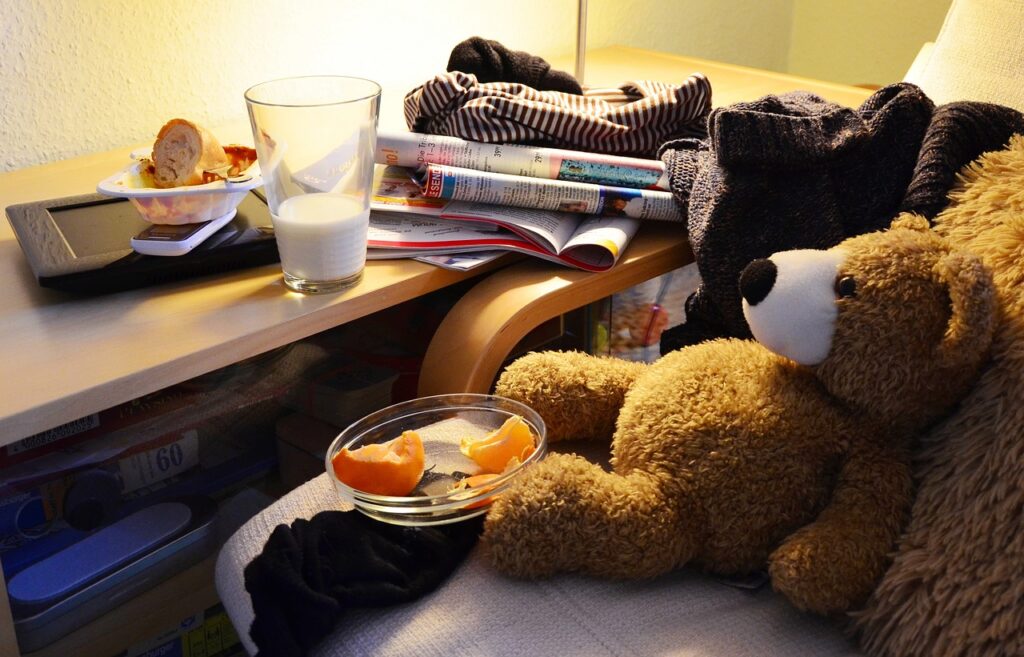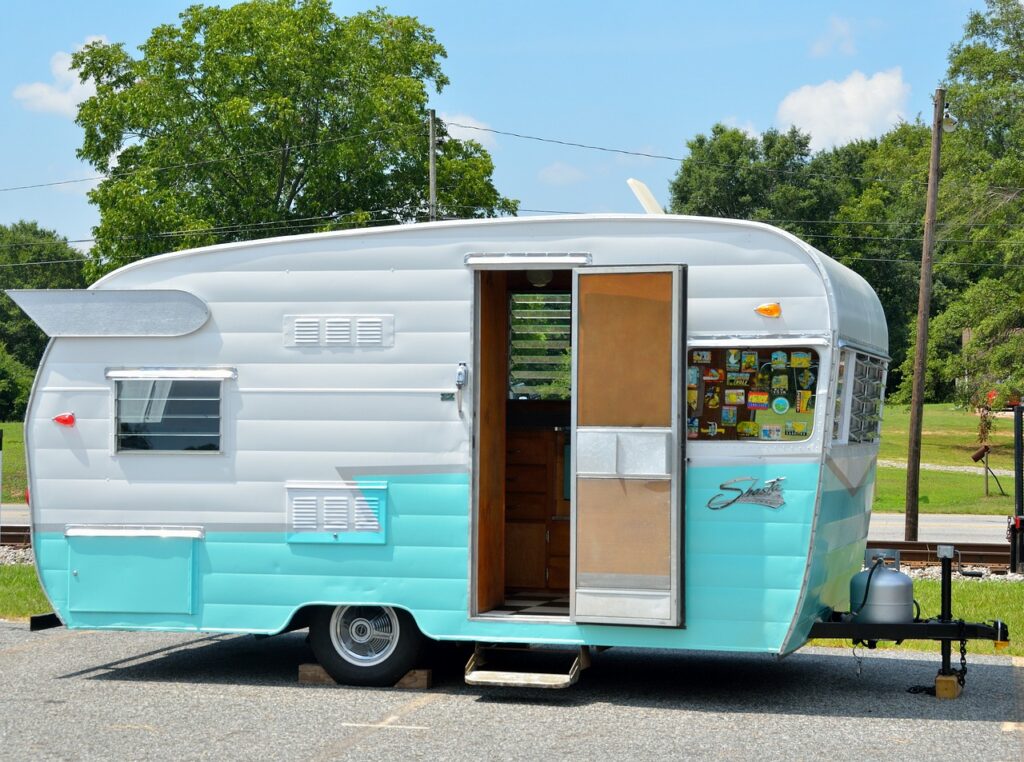Many studies have revealed that clutter is a trigger for those living with anxiety.
According to Psychology Today, Clutter makes us anxious because we’re never sure what it’s going to take to get through to the bottom of the pile.
Clutter creates guilt (“I should be more organized”) and embarrassment, especially when others unexpectedly drop by our homes or workspaces.

Imagine paring down everything you own to only what is essential and treasured. Imagine the feeling of freedom from not being buried by “stuff.”
This is not just a novel idea; millions choose to live simpler and own less. For some, it means relief from the chaos under their own room, while others are ditching the stationary “roof” to hit the road in vans, RVs, schoolies, or tiny houses on wheels to discover the beauty of our land.

This newfound clarity could possibly be a by-product of the forced time of reflection and slowing down in 2020, but this new direction of “more is less” appears to be here to stay.
Personally, I prefer to live Lagom.
Lagom is a Swedish word that means enough, just the right amount, not too much, not too little, moderation. I am not 100% sure, but the English word minimalism is likely the closest thing we Americans have to that concept.
It’s pronounced “la-gum” and those who practice it encourage that lagom be applied to all aspects of life.
Not minimalism…but not hoarding either. Lagom is somewhere in the middle where it’s “just right.”
How to Create a Declutter Strategy
Do the piles of clutter in your home overwhelm you? Do you want a clean home but honestly do not know where to start the clean-up process? It is time to create a decluttering strategy.
Walk through your home with new eyes. Some organizers recommend entering your house, going room by room, and listing everything you want to change. Before you start doing anything, take a close look at the list. Which room or space irritates you the most? Prioritize each area you want clean based on this list.
Rather than trying to tackle an entire room, start with one small area. Focus on that area – a counter, a dresser drawer, or a bookshelf. Completely clear everything from the area and then go through each item, choosing whether to save, donate, give, or throw it away. As you find items you want to keep, put them back until everything is back in its place. When you step back and see the cleared space, you will feel a sense of satisfaction and may feel new energy to move forward.

You may be tempted to start on the next item on the list, but waiting would be better. Give yourself a couple of days to a week to get used to having the area clean and see how you keep the area clutter-free.
You aim to develop the new habit of clearing this area. When you feel secure in keeping this one area clear, it is time to move to the next priority item on your list.
The next step is to work on another small area. You may want to have a decluttering spree, but remember that doing too much too soon can wear you out. Instead, plan to spend a minimum of 15 minutes a day cleaning. An hour or two each week would be fantastic if you can schedule more time. Follow the list of prioritized items and mark the time on your calendar. Guard the time like you would a doctor’s appointment to be sure you declutter each week.
Once you have gotten your own clutter under control, it is time to enlist the help of your family. Develop a chore chart for everyone in the family so you are not only cleaning. You may be the only one decluttering, but it only makes sense for everyone in the family to be involved in general housekeeping. It also helps to develop a routine.
As you go through clutter, whether on your own or with your family’s help, remember the importance of cleaning and getting rid of items you no longer need. You may want to put a “give away” box in each room. When you find an unwanted or unneeded item, place it into the box. Once the box is full, immediately take it to the car and donate it to a charity like Salvation Army or Goodwill. Perhaps someone else will need it.
You may feel like it is taking forever to clear the clutter, but it took more than a day or two to amass it. It will take time to get your home back in order, but once you do, you will be more likely to use the new skills you have learned and keep the clutter from returning.
Decluttering Can Be An Emotional Thing As Well
Sometimes the things that hypothetically weigh us down are things we cannot see.
They are the limiting beliefs, negative self-talk, and the old emotional wounds we carry through life like an overstuffed suitcase. This type of decluttering takes time to work through and heal from, but are oh-so worth it.
There was a very long period when I felt I was always desperately seeking.
Seeking adventure, curiosity, learning, and the excitement of being wonderstruck by the world around me. But most importantly, I was seeking relief. Relief and comfort from my emotional, mental, and physical pain. It was a craving for something.
A something I never could seem to find no matter how many air miles I wracked up.
Then the bottom fell out of my hypothetical box and my world was turned upside down in 2020. The new turmoil (worsen by a global pandemic) could have debilitated me further, but instead, it drove me to stop, think, feel, and do. I knew I was either going to be a victim or I was going to heal and get some semblance of my life back.
Slowly, I discovered that everything I needed to heal my battered soul and body was already inside me. That’s when the darkness began to recede, and the light took over.
Thanks to the urging of a long-time friend, I began to chronicle my journey from pain, despair, and confusion to the vibrant life that I am now living: a life filled with empowerment, self-healing, wellbeing, and spirituality.
I still strive for adventure, curiosity, learning, and the excitement of being wonderstruck, but now it amplifies my life instead of just being a distraction.
This roadmap to self-healing became my newest book, Thrive-Living A Self-Healed Life.

As I write this post, Thrive-Living A Self-Healed Life is available on Amazon, Kindle, and the Audrey Press Publishing website.
My goal with Thrive is to focus on Breath, Sound, Movement, and Meditation basics. Throughout my healing journey, these four things have been the Pillars of my healing. Breath is a powerful healing tool that is so much more than inhaling and exhaling. Once I discovered the joys of Sound Therapy and emersed myself into becoming a Certified Breath Coach, I felt like it was something that I’d been training for my whole life. Movement became my saving grace; to this day, my body wants to move. It still wants to move.
Your body wants to move too. I’ve learned that movement and healing go hand in hand. Meditation is so hard for many people, but I’ve found that Mindfulness Meditation is exactly what I needed to unhook my ruminating mind and just be.

What I want for each and every one of you who picks up this book is true healing and restoration to wholeness.
You don’t need to be fixed. You don’t need to be more. You just need to be wholly and vibrantly you.
I plan for you to begin a journey of self-love and self-compassion that honors all facets of your life.
Thrive-Living A Self-Healed Life is available on Amazon, Kindle, and the Audrey Press Publishing website.
